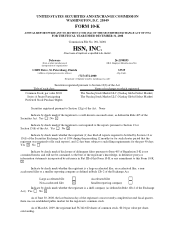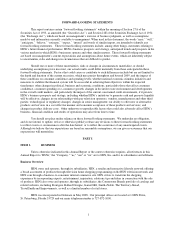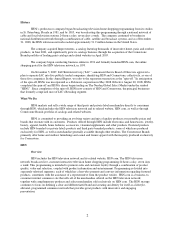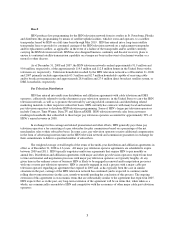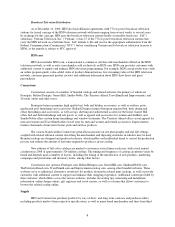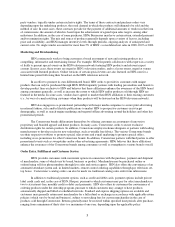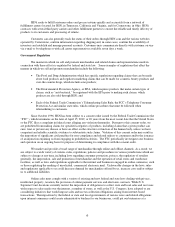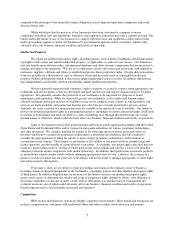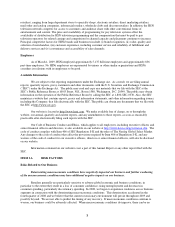Home Shopping Network 2008 Annual Report Download - page 10
Download and view the complete annual report
Please find page 10 of the 2008 Home Shopping Network annual report below. You can navigate through the pages in the report by either clicking on the pages listed below, or by using the keyword search tool below to find specific information within the annual report. 7
competitive disadvantage to the extent that similar obligations are not imposed upon their competitors and could
decrease future sales.
While we believe that the practices of our businesses have been structured in a manner to ensure
compliance with these laws and regulations, federal or state regulatory authorities may take a contrary position. Our
failure and/or the failure of any of our businesses to comply with these laws and regulations could result in fines
and/or proceedings against us and/or our businesses by governmental agencies and/or consumers, which could
adversely affect our business, financial condition and results of operations.
Intellectual Property
We regard our intellectual property rights, including patents, service marks, trademarks and domain names,
copyrights, trade secrets and similar intellectual property (as applicable), as critical to our success. Our businesses
also rely heavily upon software codes, informational databases and other systemic components that are necessary to
manage and support our operations. We rely on a combination of laws and contractual restrictions with employees,
customers, suppliers, affiliates and others to establish and protect these proprietary rights. Despite these precautions,
it may be possible for a third party to copy or otherwise obtain and use trade secret or copyrighted intellectual
property without authorization which, if discovered, might require legal action to correct. In addition, third parties
may independently and lawfully develop substantially similar intellectual properties.
We have generally registered and continue to apply to register, or secure by contract when appropriate, our
trademarks and service marks as they are developed and used, and reserve and register domain names as we deem
appropriate. We generally consider the protection of our trademarks to be important for purposes of brand
maintenance and reputation. While we vigorously protect our trademarks, service marks and domain names,
effective trademark protection may not be available or may not be sought in every country in which products and
services are made available, and contractual disputes may affect the use of marks governed by private contract.
Similarly, not every variation of a domain name may be available or be registered, even if available. Our failure to
protect our intellectual property rights in a meaningful manner or challenges to related contractual rights could result
in erosion of brand names and limit our ability to control marketing on or through the internet using our various
domain names or otherwise, which could adversely affect our business, financial condition and results of operations.
Some of our businesses have been granted patents and/or have patent applications pending with the United
States Patent and Trademark Office and/or various foreign patent authorities for various proprietary technologies
and other inventions. We consider applying for patents or for other appropriate statutory protection when we
develop valuable new or improved proprietary technologies or inventions are identified, and will continue to
consider the appropriateness of filing for patents to protect future proprietary technologies and inventions as
circumstances may warrant. The issuance or assessment of the validity of any patent involves complex legal and
factual questions, and the breadth of claims allowed is uncertain. Accordingly, any patent application filed may not
result in a patent being issued or existing or future patents may not be adjudicated valid by a court or be afforded
adequate protection against competitors with similar technology. In addition, third parties may create new products
or methods that achieve similar results without infringing upon patents that we own. Likewise, the issuance of a
patent to us does not mean that our processes or inventions will not be found to infringe upon patents or other rights
previously issued to third parties.
From time to time, we are subject to legal proceedings and claims in the ordinary course of business,
including claims of alleged infringement of the trademarks, copyrights, patents and other intellectual property rights
of third parties. In addition, litigation may be necessary in the future to enforce our intellectual property rights,
protect trade secrets or determine the validity and scope of proprietary rights claimed by others. Any litigation of
this nature, regardless of outcome or merit, could result in substantial costs and diversion of management and
technical resources, any of which could adversely affect our business, financial condition and results of operations.
Patent litigation tends to be particularly protracted and expensive.
Competition
HSNi brands and businesses operate in a highly competitive environment. These brands and businesses are
in direct competition for consumers with traditional offline and online retailers (both television and internet

